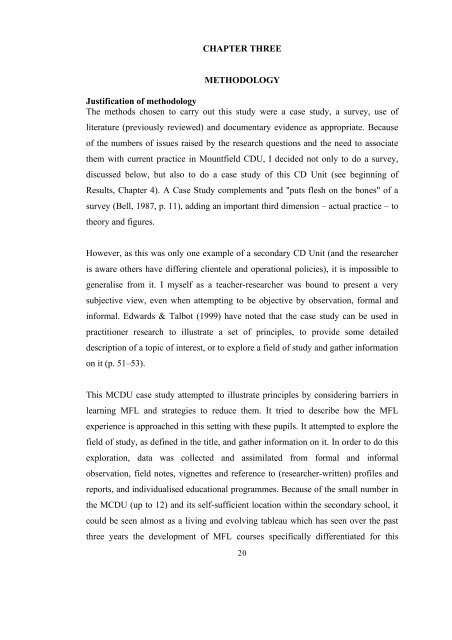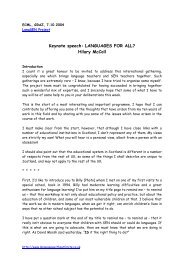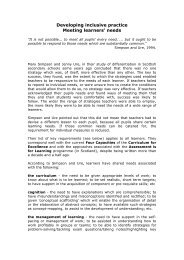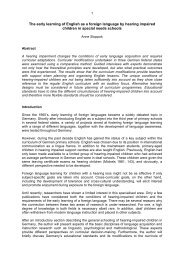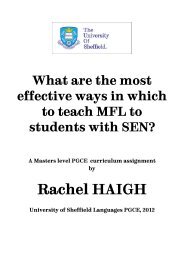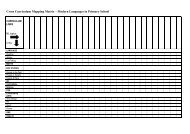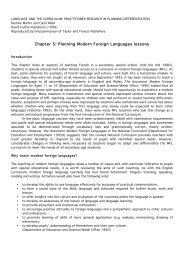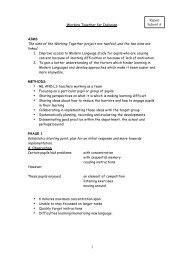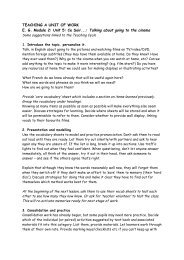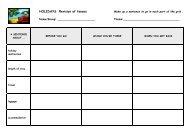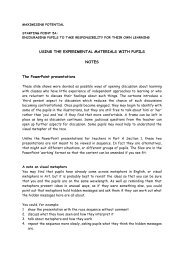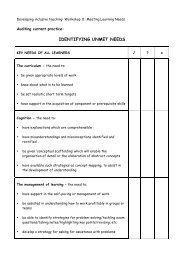CHAPTER THREE METHODOLOGY Justification of methodology ...
CHAPTER THREE METHODOLOGY Justification of methodology ...
CHAPTER THREE METHODOLOGY Justification of methodology ...
You also want an ePaper? Increase the reach of your titles
YUMPU automatically turns print PDFs into web optimized ePapers that Google loves.
<strong>CHAPTER</strong> <strong>THREE</strong><strong>METHODOLOGY</strong><strong>Justification</strong> <strong>of</strong> <strong>methodology</strong>The methods chosen to carry out this study were a case study, a survey, use <strong>of</strong>literature (previously reviewed) and documentary evidence as appropriate. Because<strong>of</strong> the numbers <strong>of</strong> issues raised by the research questions and the need to associatethem with current practice in Mountfield CDU, I decided not only to do a survey,discussed below, but also to do a case study <strong>of</strong> this CD Unit (see beginning <strong>of</strong>Results, Chapter 4). A Case Study complements and "puts flesh on the bones" <strong>of</strong> asurvey (Bell, 1987, p. 11), adding an important third dimension – actual practice – totheory and figures.However, as this was only one example <strong>of</strong> a secondary CD Unit (and the researcheris aware others have differing clientele and operational policies), it is impossible togeneralise from it. I myself as a teacher-researcher was bound to present a verysubjective view, even when attempting to be objective by observation, formal andinformal. Edwards & Talbot (1999) have noted that the case study can be used inpractitioner research to illustrate a set <strong>of</strong> principles, to provide some detaileddescription <strong>of</strong> a topic <strong>of</strong> interest, or to explore a field <strong>of</strong> study and gather informationon it (p. 51–53).This MCDU case study attempted to illustrate principles by considering barriers inlearning MFL and strategies to reduce them. It tried to describe how the MFLexperience is approached in this setting with these pupils. It attempted to explore thefield <strong>of</strong> study, as defined in the title, and gather information on it. In order to do thisexploration, data was collected and assimilated from formal and informalobservation, field notes, vignettes and reference to (researcher-written) pr<strong>of</strong>iles andreports, and individualised educational programmes. Because <strong>of</strong> the small number inthe MCDU (up to 12) and its self-sufficient location within the secondary school, itcould be seen almost as a living and evolving tableau which has seen over the pastthree years the development <strong>of</strong> MFL courses specifically differentiated for this20
group. The case study therefore described this tableau at one point in time (Spring2001) with one set <strong>of</strong> high-functioning communication-disordered pupils with theirindividual and group needs. It could not therefore produce reliable data, which couldbe replicated by another researcher, as the variables would change with the mix <strong>of</strong>pupils. It attempted to provide data, which may be valid in considering these specificresearch questions relating to the MFL learning experience <strong>of</strong> the 2001 class groupsin the MCDU. All confidential data has been presented in an anonymous way,observing ethical standards. The necessary consents were given. The survey was theother principal means <strong>of</strong> collecting data, comprising three questionnaires and fourinterviews.The survey is described by Edwards & Talbot (1999, p. 88) as being like an onion,with data from questionnaires similar to peeling <strong>of</strong>f some outer layers <strong>of</strong> skin, butbeing supplemented by interviews to get to the in-depth layers. As the case study,mentioned above, has provided the core on to which others build layers <strong>of</strong> data, thesurvey seemed a useful method to adopt to complement it.Bell (1987, p. 13) has suggested that a representative selection <strong>of</strong> the population canbe targeted by a survey, which was my intention with Questionnaires One and Two(see appendix one.)As the focus <strong>of</strong> my research is not a well-researched topic, I needed to get somebackground information accessed from a distance. As Edwards & Talbot point out,questionnaires are useful, although on the minus side they provide neither depth nora good return.Questionnaire One (see appendix one)This targeted some education authorities for a broad picture <strong>of</strong> the situation <strong>of</strong> CDpupils in schools, where there is no dedicated autism base. These were sent by post to10 regions in different parts <strong>of</strong> Scotland, and although I received replies from overhalf, only three completed enough <strong>of</strong> this questionnaire for the information to beuseful. However, I received some helpful information from some <strong>of</strong> the others, for21
example, the Highland Council Gaelic medium education programme report,mentioned earlier. Therefore, it was a worthwhile exercise. The data collected fromthis questionnaire helped me towards answering research questions one and two.Questionnaire Two (see appendix one)This was sent to identified communication disorder units attached to six secondaryschools across Scotland. Again, it was a practical way to collect a lot <strong>of</strong> detailedinformation about this group and their modern language learning experience withouttravelling extensively around Scotland, although another unit outside Glasgow wasvisited. There was no return from one recently established base. Another unit wasunable to assist much, as I learnt by a telephone call from their principal teacher thata modern language is not <strong>of</strong>fered to their pupils (which is interesting in itself, but notexplored in this study). Data gathered in this questionnaire was partly quantitative,but mainly qualitative, some questions being answered very fully. This data hashelped to give some triangulation to the case study on Mountfield CDU, withoutwhich it would be even harder to assess how typical the findings at MCDU are.Inevitably, the data will be presented with unintentional bias on the part <strong>of</strong> theresearcher.Questionnaire Three (see appendix one)This questionnaire was sent to Mountfield CDU parents specifically to address RQ 4,which tried to probe parents' opinions about the value <strong>of</strong> their child’s experience <strong>of</strong>learning a foreign language. The response was excellent, and parents (although notasked to do this) appeared to have discussed the questions with their children and tohave given carefully considered responses. The questionnaire was returnedanonymously, as I hoped for answers that would be compromised as little aspossible. The questionnaire seemed the best way to get this information rather than ata parents' night when other issues have to be discussed. The parents who repliedseemed happy to co-operate.Interviews were also carried out, in order to explore the four interviewees' specialarea <strong>of</strong> expertise, which would contribute a richness <strong>of</strong> data, relating to the MFLexperience <strong>of</strong> my target group. The expert witnesses were able to stress significant22
strategies and findings (theirs or others) and gave me deeper insight into these fourinterviewees’ slant on my research questions. I paid heed to Edwards & Talbot'scautions on interviews (p. 101), and tried to keep them short (half an hour) in ordernot to overburden either the interviewee or myself (from the point <strong>of</strong> view <strong>of</strong>analysis).The interviewsThese interviews were semi-structured to allow some comparable data to becollected, but also to allow the individual interviewee some freedom to expand onpoints as they chose and elaborate on their specialist interest. This data was mainlyqualitative and, although subjective, gives some triangulation to other data from thequestionnaires and the case study. The interviews are probably not reliable data, asthey are a subjective view on that day with that interviewer and interviewee.They were conducted with some expert witnesses in various aspects <strong>of</strong> my research:a) Mainstream modern languages senior teacher (who has taught CD pupil 2 years)b) Network support manager and dyslexia researcherc) Assistant Director, MFL research organisationd) Former MFL Principal Teacher, currently author/researcher MFL/SfL issues23


